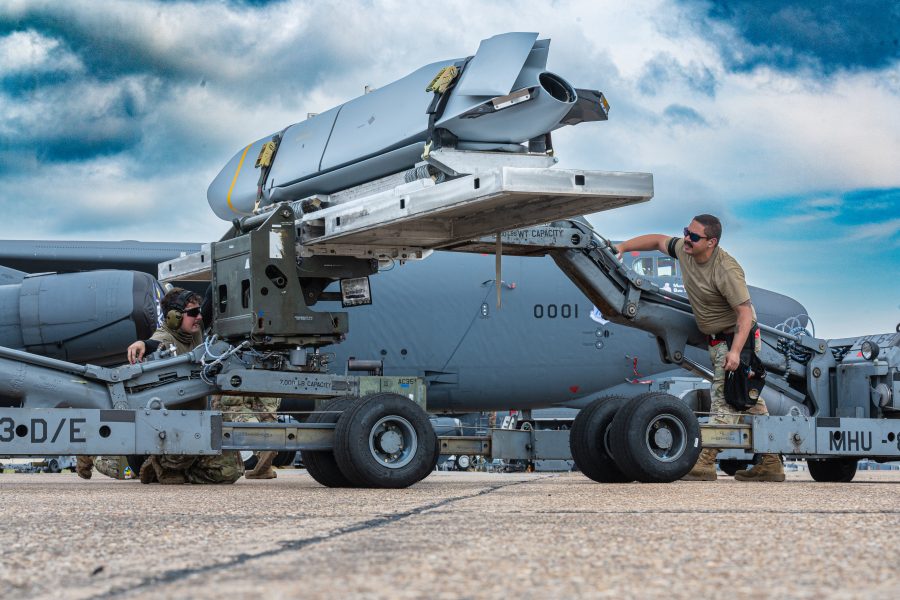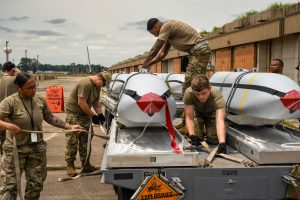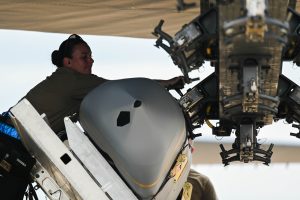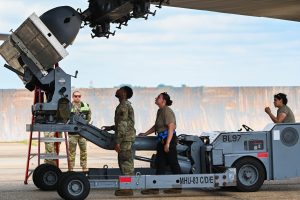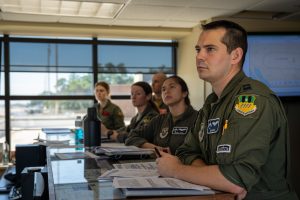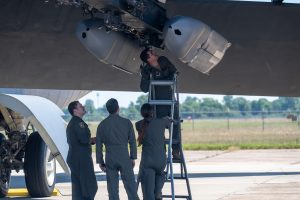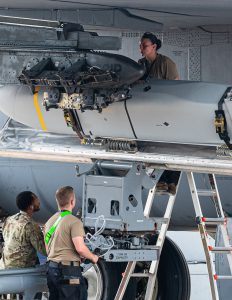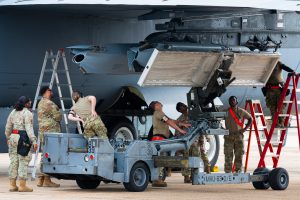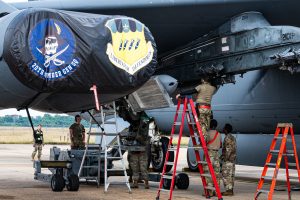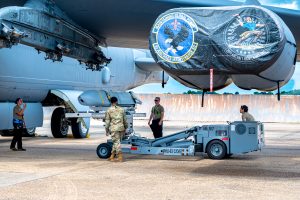BARKSDALE AIR FORCE BASE, La.—Airmen at this sprawling bomber base carried out an unusual exercise earlier this month in which they loaded AMG-158 Joint Air-to-Surface Standoff Missiles, or JASSMs, onto B-52H Stratofortresses to test their ability to conduct long-range airstrike missions.
JASSMs were not launched during Bayou Warrior, which ran June 10-13. But the exercise enabled the personnel to practice executing a conventional strike with live munitions, something the Air Force rarely does with these weapons, which cost upwards of $1 million dollars apiece.
The B-52 has deployed a diverse variety of weapons throughout its 60-year history, and the platform still inspires awe as a symbol of U.S. nuclear might.
But the Stratofortress has only been employed as a conventional bomber, and its likely future lies not with high-altitude gravity bombing or low-level penetration strikes but with the use of standoff cruise missiles from its bomb bay and massive wings.
“This one was a unique flavor,” Col. Michael D. Maginness, the commander of the 2nd Bomb Wing, which conducted the exercise, said in an interview with Air & Space Forces Magazine. “We actually flew the weapons, which was an outstanding opportunity for our aircrew.”
Wing leadership was also involved in the exercise as the Crisis Action Team went through the paces as if his bombers were actually employed in combat, Maginness said.
Air Force Global Strike Command’s inspector general office evaluated weapons loading and maintenance during the exercise. The 2nd Bomb Wing is AFGSC’s largest bomber wing and the host unit at Barksdale, which houses the major command’s headquarters.
“They’re going to come in, and they’re going give you a hard look at, “Are you ready to go?” said Col. Bryan J. Walter, who previously served as the deputy inspector general for AFGSC before taking command of the 2nd Operations Group at the end of May.
Maginness said the crews would benefit from the scrutiny.
“I’d be scared if we didn’t find anything, to be honest, because it means we weren’t looking hard enough,” Maginness added. “This is like getting a math problem wrong on the test, except when you do, you owe the teacher back how you’re going to fix it for the future and then prove to her that it’s fixed.”
While the details of the simulated combat were classified, wing officials said that it replicated a real-world scenario.
“We’ll develop some intelligence-based scenario that would drive us towards something where we would get a conventional tasking,” said Lt. Col. Amanda Goncalves, the 2nd Operations Support Squadron commander and the former inspector general of the 2nd Bomb Wing. “Here’s the U.S. response. This is how you got to this situation in this scenario. You are now being asked by a combatant command to generate so many aircraft, so many weapons, in so much time. So that sets the tone. That sets that real-world scenario for our crews, that, no kidding, you have a period of time you have to get these jets ready, loaded, and airborne.”
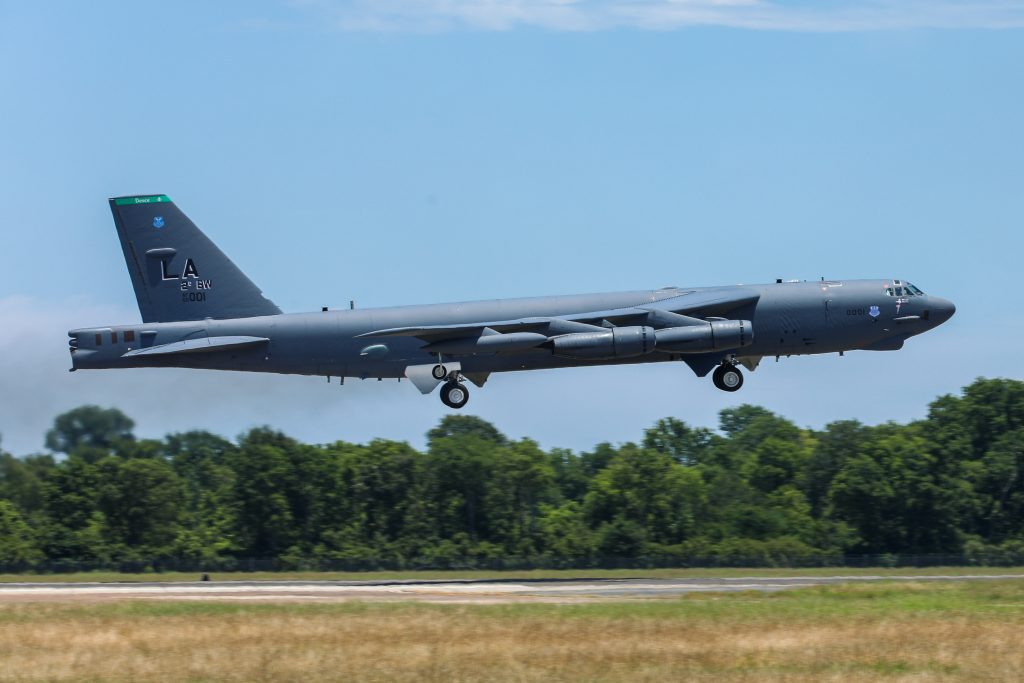
For the B-52, each sortie is no small feat. Most hangers are far too small to fit the bomber, so the ramp at Barksdale is flush with B-52s. Just over half of Air Force B-52s are “mission capable” at any one time, according to Air Force figures, which the service defines as being able to perform at least one of its core missions.
Airmen acknowledged the challenges of getting a 60-year-old jet ready for simulated combat, comparing it to getting a team ready for a playoff game.
“It’s a very old aircraft. It’s a lot of work, but our guys are great at their job,” said Master Sgt. Nickolas Shelton, production superintendent with the 2nd Aircraft Maintenance Squadron. “It’s about time management, people management, parts management. It’s nothing to worry about. The airplane’s going to make a decision on if it breaks or not. We just fix it.”
Air Force exercises and the process to improve are well established. Less so is the opportunity to train with the high-end weapons B-52s might employ.
Those weapons crews train with an array of inert weapons, including AGM-86 Air-Launched Cruise Missiles (ALCMs), which are a key element of the nuclear weapons arsenal. But putting actual JASSMs on a B-52 was a rare experience.
“Due to some of the characteristics of the JASSM, the airplane flies a little different,” said Maginness, who has roughly 3,700 flight hours—400 of them in combat—on B-52s. With JASSMs on the wings, B-52s carry fuel in specific parts of the aircraft as ballast to keep the center of gravity in line.
“Getting to actually interface with the real weapon, and seeing the weapon, the weapon generated launch regions, and the weapon data on the screens, that’s a huge training opportunity,” Maginness added.
His Airmen agreed.
“It’s not that common for us to actually fly around with JASSMs on the pylons,” said Capt. Timothy Walraven, a weapon systems officer with the 20th Bomb Squadron who has participated in a live-fire JASSM test. “So this is a big deal because there are some differences between the indications of simulation in the jet versus actually having the shapes on the jet. It’s good for aircrew to fly with this because it makes them more proficient in the sense that they have a better idea of what they’re going to see, so that way, we can be ready to go anytime.”
